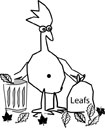
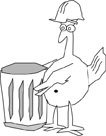 Chickens as
Bio-recyclers
Chickens as
Bio-recyclers
and Zero Waste Partners
Saving BIG TIME Tax Payer Dollars
_______________________________________________________________
Home | Store | Master Backyard Chicken Keeper™ Certification | Contact Us
Coop Corps | Poultry & Garden Clubs | Chicken Stimulus Packages | Consulting Services | Gossamer Foundation |
Partners, Sponsors & Endorsers | Affiliate Program
Introduction to Chickens as
Bio-recyclers and Zero Waste Partners
There are many local food reasons to keep family flocks, but the most economic and politically compelling reason is to employ chickens to bio-recycle kitchen, garden and yard “waste”. Employing chickens means all that biomass (food, grass clippings, leaf and yard waste) never has to leave the backyard.
Most local governments are budget-strapped; some are close to defaulting on loans. Encouraging the use of family flocks as biomass recyclers is an expense-cutting opportunity to slash amount of funds spent on managing trash that has to be picked up, transported, often transferred, and disposed of.
Nationwide, food scraps make up about 17 percent (29 million tons) of what we send to landfills.
Yard waste totals just about that same amount, 33 million tons. Food and yard waste combined represent about 28% of all municipal solid waste generation. Much of that household organic waste that could be bio-recycled in backyards and never even leave the property.
A policy (and goal) many municipalities have adopted is zero waste. Just as it implies, in a zero waste system there isn’t any waste. Everything becomes “residuals” that can recycled to one form or another. Everything is viewed as an asset.
Here’s how it works employing chickens as zero waste partners.
Part 1. Chicken Feed
A chicken eats about its weight in food every month. A standard size chicken eats about 7 pounds of feed per month. This is about 84 pounds of food/year. (1 chicken)(7 pounds food residuals/month)(12 months) = about 84 pounds per chicken.
 Some of this “chicken feed” can come from your kitchen and yard instead of a store-bought bag. Every cold piece of pizza, moldy bread, stale potato chips, popcorn, food cleaned out from the refrigerator that has “gone by”, and even that old mincemeat cake from last Christmas, can be bio-recycled or composted—with help from your family flock. Rethink the value of kitchen and yard "residuals" as building your organic equity.
Some of this “chicken feed” can come from your kitchen and yard instead of a store-bought bag. Every cold piece of pizza, moldy bread, stale potato chips, popcorn, food cleaned out from the refrigerator that has “gone by”, and even that old mincemeat cake from last Christmas, can be bio-recycled or composted—with help from your family flock. Rethink the value of kitchen and yard "residuals" as building your organic equity.
Part 2. Many Family Flocks
If a city had 2,000 households with family flocks of 6 chickens (or more) each they could feasibly divert over 500 tons of biomass from the trash stream. Here’s the math. (6 chickens)(84 pounds/year)(2,000 households) = 504 tons/year. The chickens eat some of the food scraps, some is covered over by a deep mulch scratching area, and their manure is combined with high-carbon compost is composted.
Understand that a family flock can not get all their feed from household kitchen scraps. There’s usually not enough from a single household’s food for the chickens to get a complete diet. You must still make other feed available even though they are getting some of their feed from food scraps.
But, even though your chickens don't eat all the kitchen scraps, you can still divert 100% of the kitchen and yard residuals from trash collection.
This is because there are several ways to bio-recycle the residuals by employing chickens. Chicken poo is one of the richest of all the animal manures. It has a nitrogen, phosphorous, potassium (N-K) ratio of about 1.1 .8 .5.
Mix the chicken manure “green” nitrogen to the yard carbon “browns” and you 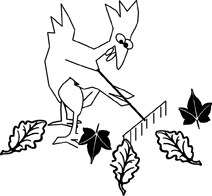 can get the 1 to 50 ratio for creating compost. So in addition to food scraps, chickens can also help divert grass clippings and yard waste into compost and top soil.
can get the 1 to 50 ratio for creating compost. So in addition to food scraps, chickens can also help divert grass clippings and yard waste into compost and top soil.
Part 3. Find the Local Expense/Ton of Trash Disposal
To a rough estimate how much chickens can save with their services you need to find out what the expenses for solid waste management. Your city manager will have the numbers. Get the total cost of the solid waste management per year and divide that by the tons of waste managed. This gives cost/ton of waste.
If you can, get numbers for residential tons collected. If the residential trash collection is not broken down, use 25% of the total trash managed as an estimate.
In this example, it cost (in 2009), about $106/ton for the city to pick up, transport, transfer and dump trash to the land fill.
Next, find what your local tipping fees. A tipping fee is the cost per ton, to dump trash. A landfill charges tipping fee to pay for the cost of opening, maintaining and eventually closing the site. This fee may, or may not be included in the total solid waste management budget.
In the Northeast, the average tipping fee in 2009 averaged $53/ton. For our example, take multiply the tipping fee ($53/ton) times (504 tons diverted by chickens) = $26,700 tax dollars saved just from not paying tipping fees!
Step 4. Total Trash Costs
The last calculation is to add the tipping fee and solid waste management costs and you get a savings total of about:
• Estimated chicken & compost generated savings from not collecting trash = $54,424/year in this example.
• Tipping fee savings = $26,700/year
• Total = $81,124/year estimated taxpayer savings.
In this oversimplified example, just by allowing folks keep family flocks as bio-recyclers and compost creators, the city could save about $81,000.
Keeping chickens is not for everyone; and it shouldn’t be. A genera estimate is that about 5 to 10% of households might be interested in keeping a family flocks.
But in truth, irregardless what the actual numbers might be, there is a genuine savings to tax payers—and a boost to local foods.
The city of Diest in Flanders, Belgium officially use chickens to reduce their trash management budget. Diest bought, and gave, laying hens to 2,000 households. They had a line item expense in their budget to purchase chickens to give to residents. City officials are employing chickens as an economical solution to their costly problem of trash management. From the city manager’s point of view, the chickens’ production of eggs, topsoil, and fertilizer are simply irrelevant as unintended benefits to residents.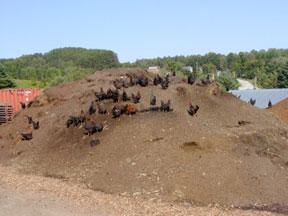
Another example is the Vermont Compost Company (VCC). This compost company's address is Main Street, in Montpelier, the state capital of Vermont. It's located within the city limits on 5 acres of steep hillside. The VCC takes in about 750 tons on food "waste" from about 49 food residue producing institutions including schools, prison, restaurants, etc. They mix the food scraps in with wood chips, old hay, just about any source of carbon and create organic compost and potting soil. What is even more remarkable is that the VCC employs about 1,200 chickens as compost workers. The chickens clean the compost piles, keep the bugs and varmints down, and by scratching, literally bring down and aerate mountains of compost.
The VCC estimates that the working chickens are worth about 6 tons of heavy, fuel-free equipment. The flock doesn't even work for chicken feed because they get all of their ration from the compost mountains.
In summary, the protocol to gather data and estimate tax-payer cost savings can be done at the local level. The Chickens and You Training Series has classes in keeping chickens as biomass recyclers and composting. This triple home-run hitter strategy not only to not only help ease strapped city budgets, but also help enhance local foods, create topsoil and enables community food self-sufficiency.
The bottom line is that simply by changing a few lines of code to allow, and even encourage residents to keep chickens—and provide easy training in family flock and compost bio-recycling management, significant tonnage will be diverted from the trash collection stream and this will save taxpayer dollars.
Employing chickens as backyard bio-recyclers is a no-cost, appropriate technology strategy for solid waste management where most of household biomass never leaves the backyards. It is transformed into the assets of compost and top soil.
Chickens are truly "pets with benefits"
May the flock be with YOU—and Poultry Power with your Solid Waste Management Department!
There is more detail about employing clucking civic chicken workers in : City Chicks: Keeping Micro-flocks of Chickens as Garden Helpers, Compost Creators, Bio-recyclers and Local Food Suppliers. For information on consulting services, contact info@ChickensAndYOU.com
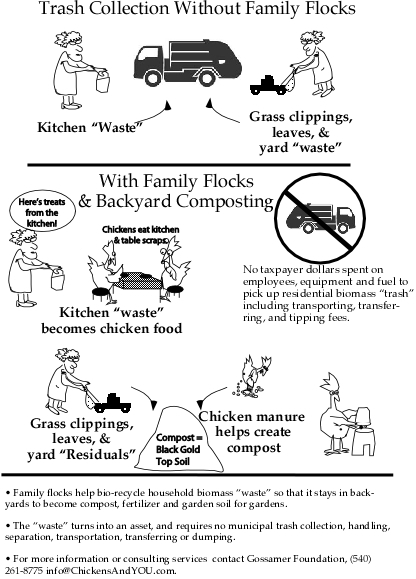
Reprinted with permission from the book City Chicks by Pat Foreman